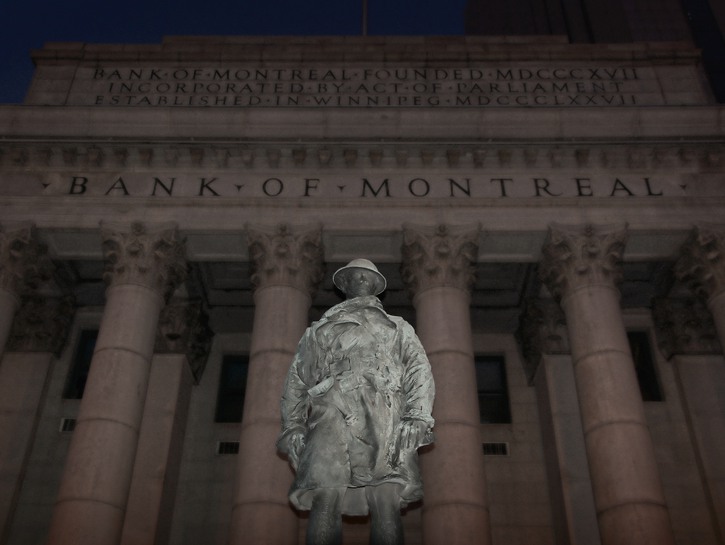
A former software development project manager, Donna Janke now devotes her time to travel and writing. She gets excited when she discovers delightful attractions in unexpected places. She finds fascinating stories everywhere, be it in her own backyard or halfway across the globe, and loves to share those stories through her writing. When not on the road, she can be found at home on the Canadian prairies. More of her stories can be found on her blog Destinations Detours and Dreams.
Videos by TravelAwaits
Because a city’s character is shaped by history, I like to learn something about the history of cities I visit by touring their places of memory. This interest naturally extends to exploring historical sites within my own city, Winnipeg, Canada.
1. The Forks
At The Forks in downtown Winnipeg, you’ll find a bustling market, a variety of dining options, outdoor patios, unique shops inside revitalized historic buildings, and performance spaces.
Although it is now a modern meeting place, this area at the junction of the Red and Assiniboine Rivers has a long legacy as a meeting ground. Archaeological research has revealed evidence of First Nations activity on this site dating back thousands of years. Later, it became a hub of the fur trade and a key site for early railroad development on the Canadian prairies.
Signboards, sculptures, and exhibits along picturesque walking paths through The Forks National Historic Site riverside park provide information about that history. The Oodena Celebration Circle is a shallow natural amphitheater that pays homage to the 6,000 years of First Nations people in the area. It features sculptures, a sundial and a ceremonial fire pit. If you’re lucky you may come across a cultural celebration as you walk by.
2. Fort Gibraltar
Fort Gibraltar is a reconstruction of an original 1809 fur trading post built by the North West Company. During the summer months, costumed bilingual interpreters bring that era back to life through the eyes of the voyageurs. (Voyageurs, French Canadians engaged in the transportation of furs by canoe, were the backbone of the North West Company.)
You can talk to the clerk in the company store, watch a blacksmith and carpenter at work, learn about the making of a canoe, and see what life was like for those who wintered here. The Fort comes alive again in February during the 10-day Festival du Voyageur, a winter festival celebrating French-Canadian culture and the history of voyageurs, Métis, and First Nations peoples.
Interpreters at the fort highlight the competition between the Hudson’s Bay Company and the North West Company that was a key characteristic of the early 19th century fur-trading era. In 1821, the two companies merged under the name ‘Hudson’s Bay Company’ — which still exists to this day. The following year, the fort was rebuilt as Fort Garry.
3. Upper Fort Garry
Modern technology is used to showcase history on the site of the original Fort Garry. The fort was rebuilt after being destroyed in an 1826 flood and renamed to Upper Fort Garry in 1835 to differentiate it from a new fort built downriver. All that remains today of Upper Fort Garry is the brick and wood Governor’s Gate. It sits at one end of what is now Upper Fort Garry Park, where raised garden beds outline locations of former buildings in the fort.

Upper Fort Garry. Photo credit: Donna Janke.
Heritage Wall, made of three layers of weathering steel, runs along the west end of the park. Symbols and images engraved in the wall depict history beginning with First Nations and continuing through the fur trade, European settlement, entry into Canada, and development of the north. A Sound and Light show runs every fifteen minutes from 10 am (11 am on weekends) to 8:45 pm. It uses sound and embedded LED lights to recreate snippets of history that include a train passing by, a stampede of bison, and French-Canadian fiddle music.
A signpost at one end of Heritage Wall provides background history to accompany the images on the wall. Alternatively, you can download the Upper Fort Garry app to your mobile device and use its GPS-enabled map to learn more about the fort’s history and the stories of its people.
Note: The site of the fort built downriver in 1835 can also be toured. Lower Fort Garry National Historic Site is located 20 miles (32 km) north of Winnipeg. Original buildings inside the limestone-walled fort are open seasonally with costumed interpreters bringing the stories of the Hudson’s Bay Company fur traders to life. However, infrastructure work starting in mid-summer 2018 and continuing through to spring 2019 will result in most of the site and buildings having restricted access during that time.
4. St. Boniface Museum
St. Boniface Museum (Le Musée de Saint-Boniface) showcases the heritage of Western Canada’s French-Canadian and Métis peoples through exhibits, dioramas, and reconstructed living spaces. It provides insight into the fur trade and pioneer life and acknowledges the contributions of First Nations and religious communities. There is an extensive exhibit covering the life of Métis leader Louis Riel, who has been called a hero, a resistance fighter, and a traitor and is known as the father of the province of Manitoba.
The museum building itself is a historical artifact. A former Grey Nuns’ convent built between 1845 and 1851, it is the oldest remaining structure in Winnipeg, and an example of a building technique known as Red River Frame construction where squared oak logs with tapered ends were stacked horizontally on a foundation of fieldstone or other available material and placed into grooves in upright timbers.
5. The Exchange District National Historic Site
Winnipeg boomed in the late 1800s when the railway came to town and it became the “Gateway to the West.” The influence of Chicago-style architecture on construction earned the city the nickname “Chicago of the North.” Today the Exchange District, located just a few blocks north of Winnipeg’s current downtown, boasts an impressive collection of heritage buildings dating from 1880 to 1920. At the time, the area was the cultural and commercial center of the city and is, therefore, steeped in history.

Winnipeg Exchange District. Flickr / daryl_mitchell
The Exchange District Biz offers a variety of themed historical walking tours highlighting architecture and cultural history, as well as some of the seamier sides of the city’s history. Alternatively, you can wander through the area on your own, admiring terracotta-clad buildings and brick and stone warehouses.
Download the On This Spot app to your mobile device and use it to pull up historical photos to compare to present day. The app also leads you through a self-guided tour called “Bullseye of the Dominion”, covering the boomtown era of 1870-1912. As you walk through the district, look for ghost signs — faded painted advertisements on the side of brick buildings that tell stories of past eras.
When you’ve had your fill of history, explore the unique shops and many restaurants of today’s Exchange District.
6. Dalnavert Musum
Dalnavert Museum, located in downtown Winnipeg, is the former home of Hugh John Macdonald, magistrate, Premier of Manitoba and son of Canada’s first Prime Minister. The Queen Anne Revival style house was built in 1895. Tours through the restored house, which is decorated in period style, provide a glimpse into upper-class life in Winnipeg in the late 1800s and early 1900s. The house was equipped with all the modern conveniences of the time: a coal boiler, hot and cold running water, electricity, an intercom system, and a telephone.
Have fun exploring the past of Winnipeg!

Dalnavert Museum. Photo credit: Donna Janke.
